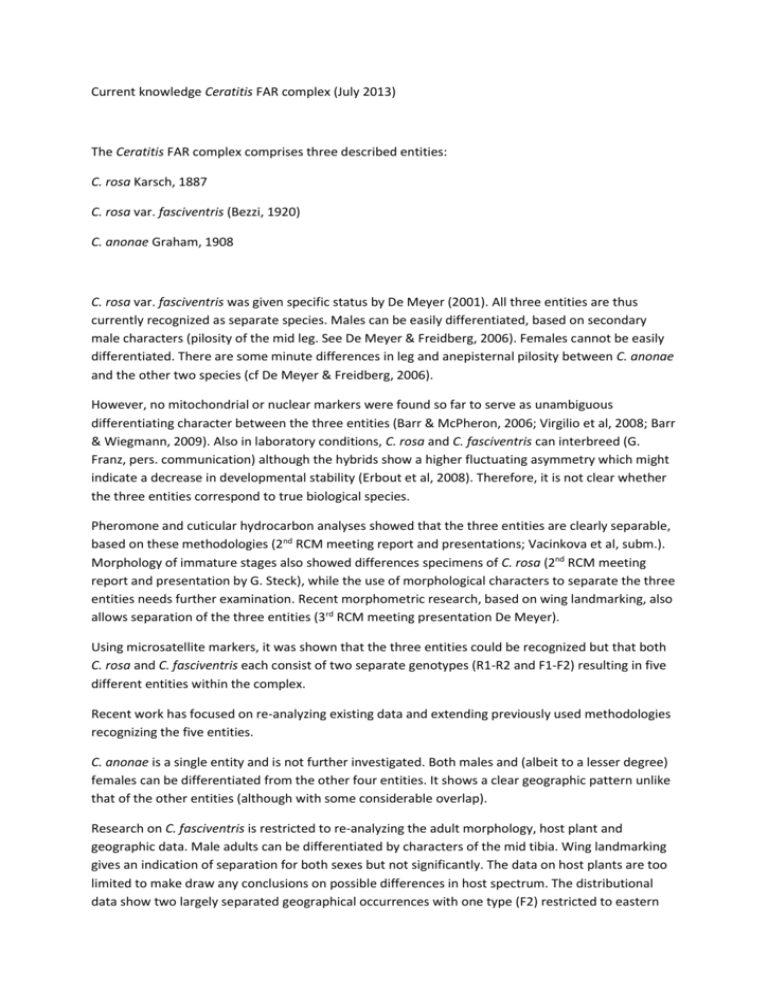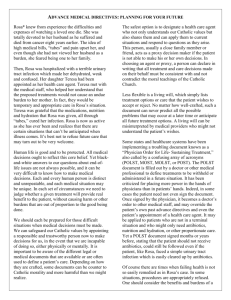Current Status Ceratitis FAR complex-DeMeyer-July 2013
advertisement

Current knowledge Ceratitis FAR complex (July 2013) The Ceratitis FAR complex comprises three described entities: C. rosa Karsch, 1887 C. rosa var. fasciventris (Bezzi, 1920) C. anonae Graham, 1908 C. rosa var. fasciventris was given specific status by De Meyer (2001). All three entities are thus currently recognized as separate species. Males can be easily differentiated, based on secondary male characters (pilosity of the mid leg. See De Meyer & Freidberg, 2006). Females cannot be easily differentiated. There are some minute differences in leg and anepisternal pilosity between C. anonae and the other two species (cf De Meyer & Freidberg, 2006). However, no mitochondrial or nuclear markers were found so far to serve as unambiguous differentiating character between the three entities (Barr & McPheron, 2006; Virgilio et al, 2008; Barr & Wiegmann, 2009). Also in laboratory conditions, C. rosa and C. fasciventris can interbreed (G. Franz, pers. communication) although the hybrids show a higher fluctuating asymmetry which might indicate a decrease in developmental stability (Erbout et al, 2008). Therefore, it is not clear whether the three entities correspond to true biological species. Pheromone and cuticular hydrocarbon analyses showed that the three entities are clearly separable, based on these methodologies (2nd RCM meeting report and presentations; Vacinkova et al, subm.). Morphology of immature stages also showed differences specimens of C. rosa (2nd RCM meeting report and presentation by G. Steck), while the use of morphological characters to separate the three entities needs further examination. Recent morphometric research, based on wing landmarking, also allows separation of the three entities (3rd RCM meeting presentation De Meyer). Using microsatellite markers, it was shown that the three entities could be recognized but that both C. rosa and C. fasciventris each consist of two separate genotypes (R1-R2 and F1-F2) resulting in five different entities within the complex. Recent work has focused on re-analyzing existing data and extending previously used methodologies recognizing the five entities. C. anonae is a single entity and is not further investigated. Both males and (albeit to a lesser degree) females can be differentiated from the other four entities. It shows a clear geographic pattern unlike that of the other entities (although with some considerable overlap). Research on C. fasciventris is restricted to re-analyzing the adult morphology, host plant and geographic data. Male adults can be differentiated by characters of the mid tibia. Wing landmarking gives an indication of separation for both sexes but not significantly. The data on host plants are too limited to make draw any conclusions on possible differences in host spectrum. The distributional data show two largely separated geographical occurrences with one type (F2) restricted to eastern Africa, while the other type (F1) mainly found in western and central Africa (this separations was also confirmed by the markers used in Virgilio et al., 2008). However the latter type is also found in some isolated areas in Angola, Malawi, Tanzania and Zambia. No clear geographical or other pattern could be detected. The lack of an established colony of both types has prevented providing material for some of the other studies (like larval morphology or pheromones) and did not allow to check on mating incompatibility and physiological differences. Currently there is an established colony of F2 type (from eastern Africa) at ICIPE (Kenya). Contacts have been made with researchers in western Africa but establishment of live colony of F1 has been unsuccessful so far. Most research has been focusing on the two C. rosa types, also because C. rosa is considered economically the most important species within the complex. Adult males can be differentiated, based on characters of the male mid tibia. Wing landmarking gives an indication of separation for both sexes but not significantly. There is conflicting information in the literature regarding developmental physiology and climatic niche for C. rosa (De Meyer et al, 2008; Duyck et al , 2002, Grout & Stoltz, 2007). Re-analysis of distributional data indicate that this might be because of failure to recognize the two types that were indicated by the microsatellite study. One type, R2, appears to occur at lower latitudes on the African continent and at higher altitudes. It might be more cold resistant than R1 type that is absent from the colder parts (lower latitudes, higher altitudes) within the geographic range of C. rosa. In order to corroborate this with experimental data, physiological development experiments are set up by different teams throughout the range of the species (South Africa, Tanzania, Kenya). So far live colonies of both types have be established only in Kenya by ICIPE. South African and Tanzanian teams are currently setting up live colonies. Preliminary results on the Kenyan experiments will be presented at the 3rd CRM. In addition, material from the colonies at ICIPE has been made available to other teams for study of larval morphology and cuticular hydrocarbons. Preliminary investigation of larval morphology between R1 and R2 from Kenya has not shown any differences (but there is marked difference with earlier studied material of C. rosa (type unknown) from South Africa. Further results will be presented a the 3rd CRM. Mating compatibility experiments have been conducted between the two C. rosa (R1-R2) and the C. fasciventris (F2) populations at ICIPE. These results will also be presented at the 3rd CRM. Conclusions - - All evidence so far points towards the fact that the three recognized species within the FAR complex are indeed three separate species Further evidence indicate that C. rosa and C. fasciventris might each comprise two different entities, while C. anonae remains a single entity For the two C. fasciventris types, there is only the indication of some adult morphological differences and different biogeographic patterns. The latter are not completely understood so far. Further investigation in the status of the two entities will require the establishment of live colonies. For the two C. rosa types, there is some evidence that these are indeed two separate species. Results presented at the 3rd CRM and further research that is planned in the forthcoming months might further reveal the exact status of these two entities.




